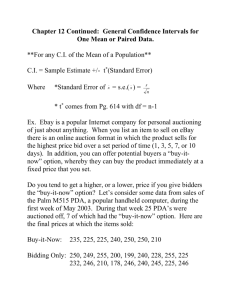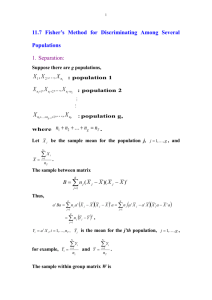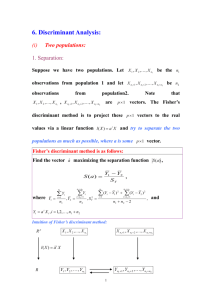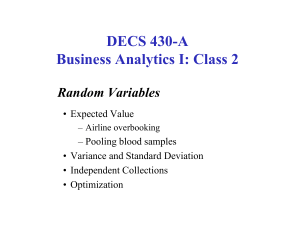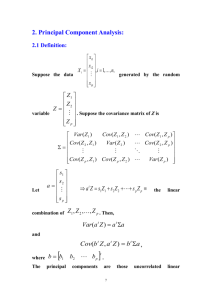11.5 Fisher`s discriminant function
advertisement
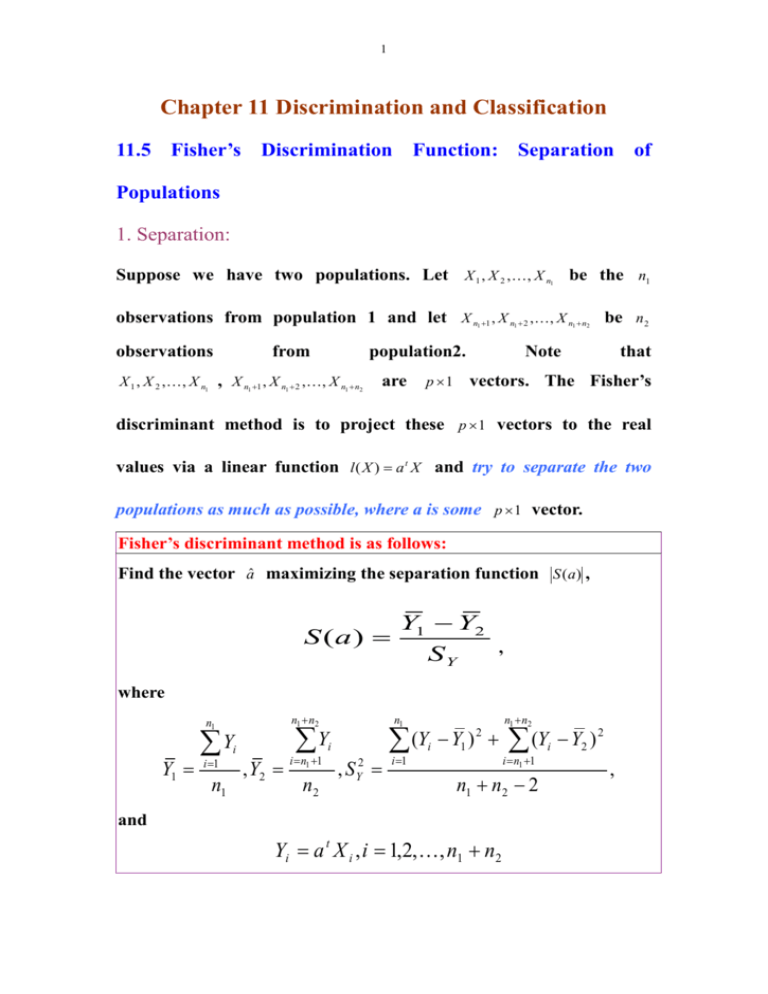
1 Chapter 11 Discrimination and Classification 11.5 Fisher’s Discrimination Function: Separation of Populations 1. Separation: Suppose we have two populations. Let X 1 , X 2 , , X n 1 be the n1 observations from population 1 and let X n 1 , X n 2 ,, X n n be n 2 1 observations from 1 population2. X 1 , X 2 , , X n1 , X n1 1 , X n1 2 , , X n1 n2 are 1 2 Note that vectors. The Fisher’s p 1 discriminant method is to project these p 1 vectors to the real values via a linear function l ( X ) a t X and try to separate the two populations as much as possible, where a is some p 1 vector. Fisher’s discriminant method is as follows: Find the vector â maximizing the separation function S (a) , S (a) Y1 Y2 SY , where n1 n2 n1 Y1 Yi i 1 n1 , Y2 Y i n1 1 n2 n1 i , S Y2 (Y Y ) i 1 i 1 2 n1 n2 (Y Y ) i n1 1 n1 n2 2 and Yi a t X i , i 1,2,, n1 n2 i 2 2 , 2 Intuition of Fisher’s discriminant method: Rp X 1 , X 2 , , X n1 X n1 1 , X n1 2 , , X n1 n2 l ( X ) aˆ t X Yn1 1 , Yn1 2 , , Yn1 n2 Y1 , Y2 , , Yn1 R Intuitively, As far as possible by finding â Y Y2 measures the difference S (a) 1 SY between the transformed means Y1 Y2 relative to the sample standard deviation SY . If the transformed observations Y1 , Y2 , , Yn1 and Yn1 1 , Yn1 2 , , Yn1 n2 are completely separated, Y1 Y2 should be large as the random variation of the transformed data reflected by SY is also considered. Important result: The vector â maximizing the separation S (a) Y1 Y2 SY is the form of 1 X 1 X 2 S pooled , where X n1 S pooled n1 1S1 n2 1S 2 , S n1 n2 2 n1 n2 S2 X i n1 1 1 i 1 X 1 X i X 1 t i n1 1 X 2 X i X 2 t i n2 1 , , 3 and where n1 n2 n1 X1 X i 1 i and X 2 n1 X i n1 1 i n2 . Justification: n1 Xi Yi a X i t i 1 i 1 i 1 Y1 a n n1 n1 1 n1 n1 t at X 1. Similarly, Y2 a t X 2 . Also, n1 n1 n1 (Yi Y1 ) a X i a X 1 a t X i a t X 1 a t X i a t X 1 2 i 1 t t 2 i 1 t i 1 n1 t a X i X 1 X i X 1 a a X i X 1 X i X 1 a . i 1 i 1 n1 t t t Similarly, n1 n2 Y Y i n1 1 2 i 2 n1 n2 t a X i X 2 X i X 2 a i n1 1 t Thus, Y n1 S Y2 i 1 i Y1 2 n1 n2 Y i n1 1 i Y2 2 n1 n2 2 n1 n2 n1 t t a t X i X 1 X i X 1 a a t X i X 2 X i X 2 a i 1 i n1 1 n1 n2 2 4 n1 n2 n1 t t X i X 1 X i X 1 X i X 2 X i X 2 i 1 i n1 1 at n1 n2 2 a n 1S1 n2 1S 2 t at 1 a a S pooled a n1 n2 2 Thus, Y1 Y2 a t X 1 X 2 S (a) SY a t S pooled a â can be found by solving the equation based on the first derivative of S (a ) , 2S pooled a S (a) X 1 X 2 1 t a X 1 X 2 0 3/ 2 t t a 2 a S pooled a a S pooled a Further simplification gives X1 X 2 a t X 1 X 2 S pooled a . t a S pooled a Multiplied by the inverse of the matrix S pooled on the two sides gives S 1 pooled a t X 1 X 2 X 1 X 2 t a , a S pooled a at ( X1 X 2 ) Since is a real number, a t S pooled a 1 X1 X 2 , aˆ cS pooled where c is some constant. 5 2. Classification: Suppose we have an observation X 0 . Then, based on the discriminant function l ( X ) aˆ t X we obtain, we can allocate this observation to some class. Important result: Allocate X 0 to population 1 if 1 1 t 1 Yˆ0 aˆ t X 0 X 1 X 2 S pooled X 0 aˆ t ( X 1 X 2 ) (Y1 Y2 ) 2 2 = 1 1 X 1 X 2 t S pooled X 1 X 2 . 2 Otherwise, if 1 t 1 1 X 1 X 2 , then allocate X 0 to Yˆ0 ( X 1 X 2 ) t S pooled X 0 X 1 X 2 S pooled 2 population 2. Intuition of this result: Intuition of this result: X n1 1 , X n1 2 ,, X n1 n2 Rp X0 . . . . . X. .2 . . . . . . . . . . l( X ) at X l( X ) at X X 1 , X 2 ,, X n1 . . . . . .X.1.. .. .. . . . . . . l( X ) at X R Y2 Y1 Y2 2 Ŷ0 (population 2) If Ŷ0 is on the right hand side of X 0 to population 1 and vice versa. Ŷ0 Y1 (population 1) Y1 Y2 (closer to Y1 ), then allocate 2 6 Note: significant separation does not necessarily imply good classification. On the other hand, if the separation is not significant, the search for a useful classification rule will probably fruitless!! Example: Data: Table 11.8, p. 662 0.0065 0.2483 1 131.158 90.423 x1 , x , S 2 0.0262 pooled 90.423 108.147 . 0.0390 Then, 131.158 90.423 0.0065 0.2483 1 x1 x2 aˆ S pooled 0.0390 0.0262 90 . 423 108 . 147 37.61 28.92 and yˆ aˆ t x 37.61x1 28.92 x2 . Thus, 0.0065 y1 aˆ t x1 37.61 28.92 0.88, 0.0390 0.2483 y 2 aˆ t x 2 37.61 28.92 10.10 . 0 . 0262 y1 y 2 0.88 10.10 4.61 2 2 Suppose a new observation with 0.210 x0 . 0.044 Since 0.210 y1 y2 yˆ 0 aˆ t x0 37.61 28.92 6 . 62 4 . 61 2 0.044 we classify the observation to the second population. 7 Useful Splus Commands: >species<-factor(c(rep(“s”,50),rep(“v”,50))) >irsv<-rbind(iris[,,1],iris[,,2]) >irsvdf<-data.frame(species,irsv) >irsvdf >irsv.discrim<-discrim(species~.,data=irsvdf) >irsv.discrim >ircoef<-coef(irsv.discrim) >ircoef1<-ircoef$linear.coefficients[,1] >ircoef2<- ircoef$linear.coefficients[,2] # categorical variable 1 # S pooled X1 1 # S pooled X2 >ira<-ircoef1-ircoef2 1 # aˆ S pooled X 1 X 2 >yhat=irsv%*%ira # ŷ >plot(yhat)


